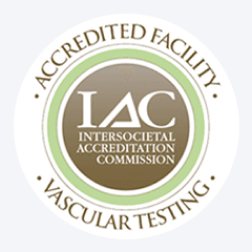Varicocele: Enlarged Veins in the Scrotum
A varicocele occurs when the veins inside the scrotum become enlarged, similar to varicose veins in the legs. This condition can cause pain, swelling, or infertility in some men. Because it’s related to poor vein function, varicoceles are part of the broader family of venous disorders that affect circulation and blood flow. It is estimated that this condition affects up to 15% of men and is typically noncancerous.
Symptoms of Varicocele
- Dull, aching pain in the scrotum, especially after standing or exercise
- Noticeable enlarged or twisted veins (“bag of worms” appearance)
- Testicular heaviness or swelling
- Reduced fertility or abnormal semen analysis
- Shrinking of the affected testicle (testicular atrophy)

Request a Consultation

What Causes Varicocele?
Varicoceles develop when the valves inside the scrotal veins that regulate blood flow fail, allowing blood to pool and the veins to enlarge. They’re more common on the left side of the scrotum due to differences in vein anatomy and blood drainage.
Risk factors include:
- Prolonged standing
- Heavy lifting
- Increased pressure in the abdomen

How Varicocele is Diagnosed
A vascular specialist will typically perform a physical exam and may order a scrotal ultrasound to assess vein size, blood flow, and the extent of the varicocele. Ultrasound imaging helps differentiate varicoceles from other potential causes of testicular pain or swelling.

Varicocele Treatment Options
While mild varicoceles may not require intervention, treatment is often recommended when symptoms, discomfort, or fertility issues arise.
Common treatments include:
- Varicocele Embolization: A minimally invasive, image-guided procedure performed by a vascular specialist to close off the enlarged veins and reroute blood flow through healthy vessels.
- Surgical Varicocelectomy: A more invasive option performed by a surgeon to remove or tie off the affected veins.
- Lifestyle Adjustments: Wearing supportive underwear, avoiding prolonged standing, and managing heavy lifting can help ease discomfort.
At United Vein & Vascular Centers, our specialists offer non-surgical, outpatient treatments like embolization to restore proper circulation, reduce pain, and improve fertility outcomes — typically with minimal recovery time.
Frequently Asked Questions
Most varicoceles are not dangerous, but they can cause pain, testicular shrinkage, or infertility if left untreated.
A varicocele occurs when the valves inside the veins of the scrotum stop working properly, causing blood to pool instead of flowing efficiently back toward the heart. This pooling increases pressure and leads to enlarged, twisted veins (similar to varicose veins in the legs). It most often affects the left side of the scrotum because of the way that vein connects to the main abdominal vein system.
While not typically life-threatening, a varicocele can become a serious health concern if it causes pain, testicular shrinkage (atrophy), or fertility problems. If symptoms persist or semen quality declines, medical evaluation is important. Treatment can prevent long-term complications and restore normal circulation.
Yes. Many men live with a mild varicocele without significant symptoms or complications. However, if discomfort, swelling, or infertility occur, treatment is recommended. Leaving a symptomatic varicocele untreated can gradually worsen pain or impair sperm quality over time.
If left untreated, a varicocele can lead to chronic pain, progressive testicular shrinkage, and in some cases, reduced fertility due to impaired sperm production and higher scrotal temperature. Early diagnosis and minimally invasive treatment — such as varicocele embolization — can prevent these complications.
Yes. Most patients fully recover after treatment, particularly with embolization or microsurgical repair. Pain relief is usually immediate or within days, and sperm quality often improves within several months. With proper care and follow-up, recurrence is rare.
